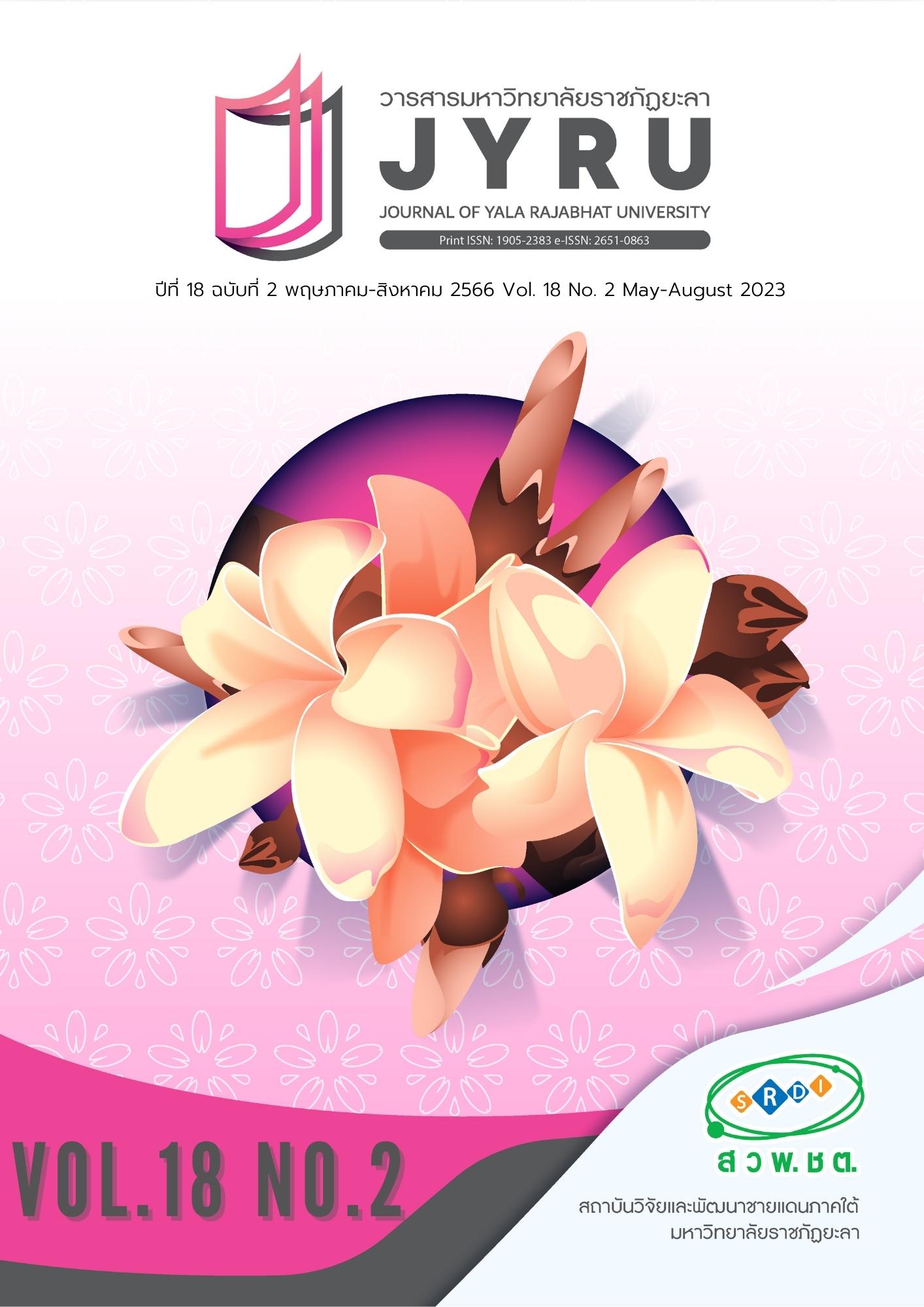การวิเคราะห์วัฒนธรรมมลายูผ่านอัตลักษณ์ตราสินค้าของร้าน Bagus Chicken ปัตตานี
Main Article Content
บทคัดย่อ
การสร้างตราสินค้าให้เป็นที่จดจำในสายตาผู้บริโภค มีความสำคัญสำหรับผู้ประกอบการในปัจจุบันที่ต้องปรับตัวเพื่อสร้างภูมิคุ้มกันและพร้อมรับมือกับวิกฤตในอนาคต การสร้างความเข้มแข็งของตราสินค้าให้เกิดขึ้น ควรพิจารณาถึงเนื้อหาและองค์ประกอบสำคัญที่สามารถสะท้อนอัตลักษณ์ตราสินค้าให้โดดเด่น และเป็นที่รู้จักในมุมมองของผู้บริโภค งานวิจัยนี้มุ่งเน้นการวิเคราะห์แบบผสมผสาน ทั้งการวิเคราะห์เชิงคุณภาพเกี่ยวกับวัฒนธรรมมลายูผ่านอัตลักษณ์ตราสินค้า กรณีศึกษาร้าน Bagus Chicken จังหวัดปัตตานี โดยการสัมภาษณ์เชิงลึกกลุ่มตัวอย่าง 2 กลุ่ม คือ ผู้ประกอบการและพนักงานร้านในฐานะ ผู้ส่งสาร และการวิเคราะห์เชิงปริมาณกลุ่มผู้บริโภคในมุมมองของผู้รับสาร เพื่อสะท้อนความเป็นจริงเกี่ยวกับอัตลักษณ์ตราสินค้า โดยวิเคราะห์เบื้องต้นเกี่ยวกับรูปแบบการสื่อสาร และขยายผลการวิเคราะห์ผ่านโมเดลปริซึมอัตลักษณ์ตราสินค้าของ Kapferer (2012) ผลการศึกษาพบว่า การสร้างอัตลักษณ์ตราสินค้าของร้าน Bagus Chicken มีการสะท้อนวัฒนธรรมผ่านอัตลักษณ์ตราสินค้าได้อย่างชัดเจน โดยเฉพาะอย่างยิ่ง ตราสินค้าที่มีรูปไก่ใส่หมวกซอเกาะ ซึ่งบ่งบอกความเป็นตัวตนของผู้คนในจังหวัดชายแดนภาคใต้ นอกจากนี้ ในมุมมองเจ้าของร้านและพนักงานเมื่อเปรียบเทียบกับลูกค้า ในมิติความสัมพันธ์กับตราสินค้าและภาพลักษณ์ส่วนตัวมีความสอดคล้องกัน ถือได้ว่ามุมมองทั้ง 2 มิติ เป็นจุดเด่นของร้าน Bagus Chicken ดังนั้น การสร้างความสัมพันธ์กับลูกค้าถือเป็นกลยุทธ์ที่สำคัญยิ่งของธุรกิจร้านอาหารที่จะสร้างความยั่งยืนในการประกอบการ และภาพลักษณ์ส่วนตัวที่โดดเด่นในเรื่องการต้อนรับลูกค้าทุกเพศทุกวัย และลูกค้าที่มาใช้บริการเป็นครอบครัว
Article Details

อนุญาตภายใต้เงื่อนไข Creative Commons Attribution-NonCommercial-NoDerivatives 4.0 International License.
บทความ ข้อมูล เนื้อหา รูปภาพ ฯลฯ ที่ได้รับการเผยแพร่ในวารสารมหาวิทยาลัยราชภัฏยะลานี้ ถือเป็นลิขสิทธิ์ของวารสารมหาวิทยาลัยราชภัฏยะลา หากบุคคลหรือหน่วยงานใดต้องการนำทั้งหมดหรือส่วนหนึ่งส่วนใดไปเผยแพร่ต่อหรือกระทำการใดๆ จะต้องได้รับอนุญาตเป็นลายลักษณ์อักษรจากวารสารมหาวิทยาลัยราชภัฏยะลาก่อนเท่านั้น
เอกสารอ้างอิง
Beverland, M. (2018). Brand management: Co-creating meaningful brands. London: Sage.
Bhattacharya, S., Kumar, R. & Dutta, A. (2017). Exploring Kapferer's brand identity prism applicability in Indian political marketing aspect with special focus to youth voters [Online]. Retrieved July 29, 2022, from: https://www.researchgate.net/publication/345689924.
Buil, I., Catalán, S. & Martínez, V. (2016). The importance of corporate brand identity in business management: An application to the UK banking sector. BRQ Business Research Quarterly, 19(1), 3-12.
Chaibanharn, J. & Hansanti, S. (2018). Identity and brand image influencing the purchase decision of Ford pick-up vehicles of consumers in Bangkok area. Journal of Modern Management, 16(1), 229-237.
Cherif, H. & Miled, B. (2013). Are brand communities influencing brands through co-creation? A cross national example of the brand AXE: In France and in Tunisia. International Business Research, 6(9), 14-29.
Cid, A., Blancet, P., Robichaud, F. & Kinuani, N. (2022). A conceptual framework for creating brand management strategies. Businesses, 2(4), 546-561.
Harntoa, K. (2016). CCTV buying decision behavior of people in Bangkok. Master’s Thesis. Silpakorn University. (in Thai)
Kapferer, J. N. (2012). The new strategic brand management. Advanced Insights & Strategic Thinking. London: Kogan Page.
Li, Y., Zhang, C., Shelby, L., & Huan, T. (2021). Customers’ self-image congruity and brand preference: A moderated mediation model of self-brand connection and self-motivation. Journal of Product & Brand Management, 31(5), 798-807.
Mohd Johan, M. R., Md. Syed, M. A., & Mohd Adnan, H. (2022). Building brand identity through social media platform during Covid-19 pandemic. Jurnal Intelek, 17(1), 151-163.
Ross, F. (2020). A perspective on the application of Kapferer's brand identity prism in the branding process of hearing aid retail companies. Journal of Management and Marketing Review, 5(3), 141-146.
Tuan Ismail, T. A., Muhammad, R., Mohd Yusoff, N., & Md Shariff, M. S. (2016). The myth and reality of hotel brand and food quality: The case of hotel restaurants in Malaysia. Procedia – Social and Behavioral Sciences, 222, 382-389.
Uimanachai, N., & Phasara, P. (2015). Guidelines for creating emotional experiences for consumers. Executive Journal, 35(1), 44-52. (in Thai)
Woranaporn, C. (2012). Factors that affect decision making options in the use of Krung Thai bank Tiwanon branch – Ministry of Public Health. Master’s Independent Study. Siam University. (in Thai)
Yamane, T. (1967). Statistics: An introductory analysis. (2nd ed.). New York: Harper and Row.
Yanoi, P. (2019). Brand identity and marketing communication by participation of community for promoting tourism Kad Kuang Mueng Nan (Wat Phumin walking street). Master’s Thesis. National Institute of Development Administration. (in Thai)
Yongvikul, M. (2013). Design feeling. Magazine to Promote Creativity, Drive the Thai Economy, 4(5), 12-18. (in Thai)
Zwakala, K., & Steenkamp, P. (2021). Identity-based brand differentiation: Brand identity prism application in South African banks. Journal of Contemporary Management, 18, 121-141.


